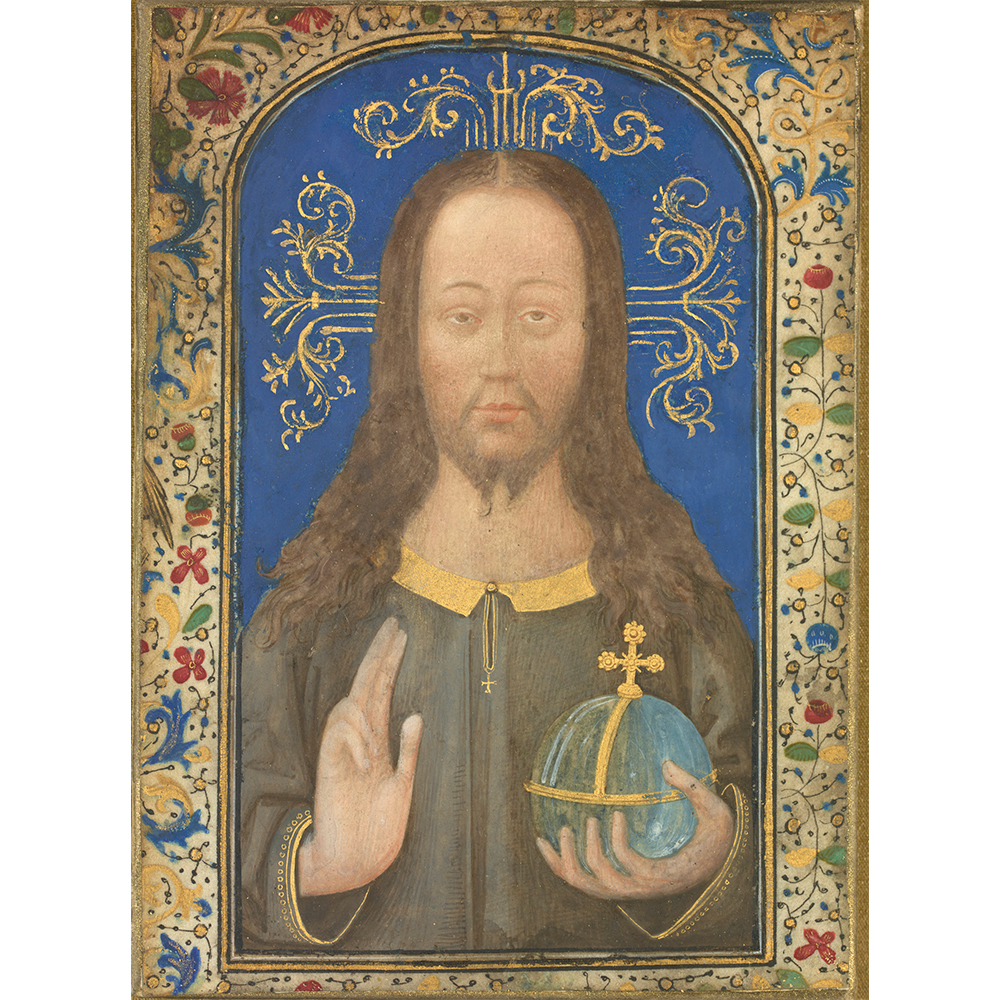Miniature of the Holy Face

Attributed to Willem Vrelant
c.1450–80
Present-day Belgium (probably Bruges)
Parchment, ink, paint, gold; in a later frame
Height: 4.9 in (12.4 cm); width: 3.5 in (9 cm)
Wyvern Collection, 0673
This image of the face of Christ is a variant of the “Veronica” icon type, a traditional image popular in the Middle Ages which presents the face of Christ as a kind of image relic. Throughout the medieval period, artists and viewers prized a close adherence to earlier models, establishing a kind of “authorized” depiction of religious figures and events. In some cases, images were even believed to hold a certain spiritual power, derived from the original, and a close copy was thought to preserve and transmit that power. According to legend, Veronica offered her veil to Christ to wipe his brow as he carried the cross to Calvary, and when he returned it to her, it was miraculously imprinted with his image. This flesh-to-fabric image, also known as the “Holy Face,” became a widespread tradition, considered to be essentially a relic of Christ by many late-medieval Christians. Many examples of the Veronica image, like the drawing by the English monk Matthew Paris, now in the British library, position the face and neckline of Christ against a cross-shaped halo with no supporting background. (1) How then are we meant to understand the supplementary accents included in the Wyvern image: Christ’s longer torso, physical beauty, and the ornamental border that encircles him?
This fragment of illuminated parchment mounted on wood presents Christ as a beautiful ideal. The gently delineated features of Christ reflect a growing interest in naturalism that is characteristic of art in the later Middle Ages, when an increasing value was placed on observations of the natural world as a source of knowledge. This image embodies other adaptations of the Veronica type: Christ’s form has been extended to the waist, his hands make a blessing gesture, and he holds a regal and celestial globe. These attributes—the motion and the royal regalia—position Christ as a spiritual king. No longer a strict adherent of the Veronica device, this work more closely resembles a visually plausible portrait of a man. Nevertheless, the visual similarity of this painting to the Veronica type still preserves and transmits the power derived of the original, the body of Christ.
The increasing preference of late-medieval viewers for devotional images with a heightened sense of artistry and aesthetic consideration is seen here in the degree of naturalism and detail, and also in changes made to the format of the image, which is now a single portrait separated from a larger sheet of parchment. The decorative border is reminiscent of a Book of Hours wherein images of the Holy Face were frequently accompanied by devotional prayers (see pp. 92–93 Keble-Petre Hours). Willem Vrelant, the artist to whom this Holy Face is attributed, was a manuscript illuminator, and is not known to have created panel paintings. This painting is likely to have been part of such an illuminated book, with a fuller border and accompanying prayer attached to it, like the image tacked onto the wall in the background of Petrus Christus’ Portrait of a Young Man, now in the National Gallery in London. (2) At some point in time, this image was trimmed to its current size and mounted, reimagined and transformed into the beautiful parchment painting surviving today.
Camila Papadopoulo, Class of 2020
Notes
- London, British Library, Arundel MS 157, fol. 2r.
- London, National Gallery, NG2593.